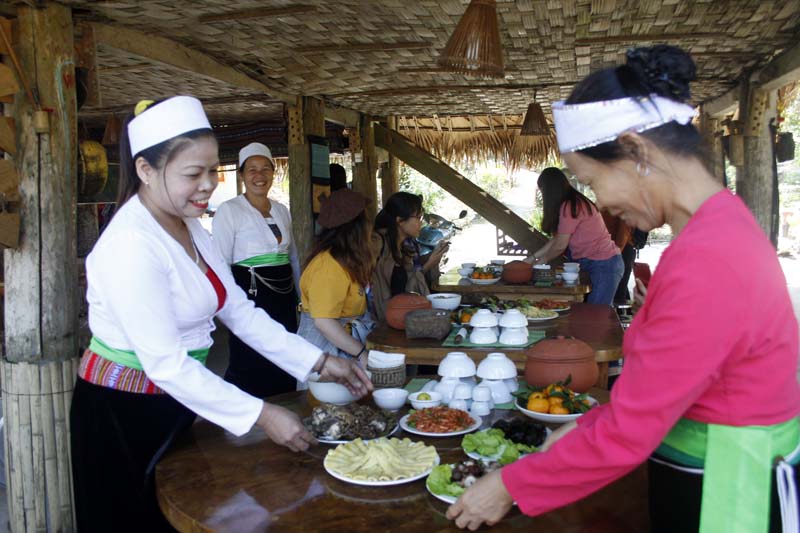
HBO – Leading us to Trach spring, Bui Thi Chi in Ke village, Hien Luong commune, Da Bac district, said that it is a pride of the village as its beauty remains intact. Next to the spring is a protective forest which belongs to the Phu Canh nature reserve. Coming to the spring in summer, visitors all want to cross it, go fishing, catch crab and shrimp, or swim.

Family of Bui Thi Chi in Ke village,
Hien Luong commune prepares meals to welcome guests.
Huu
Thao homestay is named after Chi’s son and daughter-in-law. The house faces Hoa
Binh Lake, enjoys fresh air and can serve groups of up to 12 guests. She said: "Although
the income from the community tourism is not high, it is a great opportunity for
my family to improve our living conditions. At the same time, it also creates a
new way of thinking in developing economy of the younger generation”.
Ke
village is more than 10 km from Da Bac town. The village, located next to the
Hoa Binh reservoir, is home to locals of the Muong ethnic group. It has 85 households,
including three engaging in a homestay model as part of a community-based
tourism project.
Visiting
Ke village, tourists can enjoy the medicinal bathing service of the Dao people,
along with experiencing activities on the lake and walking around the village.
The village has attracted tourists from many places with the wild beauty of the
water and experiences close to the nature. Tourists can choose between cycling
and walking around the village on a small and beautiful path lined by bamboo
and next to the lake. The place is ideal for such activities as rafting and
kayaking. Vehicles between pick-up and drop-off points can also be arranged. All
the households providing homestay service are provided with life jackets for
guests. A typical feature of Ke village is traditional dishes of the Muong
ethnic group such as charcoal-roasted pork, salt-cured pork, fish, chicken
cooked with sour bamboo shoots, and rice in bamboo tube. After dinner, visitors
can participate in a bamboo pole dance or xoe, a signature dance of the locals.
Sanh
Thuan homestay is also one of the first guesthouses in Ke village. Located right
on the main road next to Ke spring, the stilt house of Bui Van Duong's family
was renovated since 2015. The homestay, named after Duong’s son, can serve from
8-10 guests./.
A diverse chain of eco-tourism and resort destinations concentrated in Hoa Binh city and the districts of Tan Lac, Da Bac, and Luong Son… Along with the launch of several key high-quality resort tourism projects, these developments have reshaped the landscape and enhanced the appeal of Hoa Binh as a travel destination.
Boasting diverse terrain, a mild climate, and rich natural resources, Cao Phong district is increasingly asserting its place on Vietnam’s tourism map, attracting both domestic and foreign visitors. The district is renowned for its stunning landscapes, majestic mountains, a crystal-clear hydropower lake, and the unique cultural identity of local ethnic groups.
With its pristine landscapes, unique cultural heritage of Muong ethnic minority, and an expanding range of visitor experiences, Tan Lac district of Hoa Binh has fast become a captivating destination for both domestic and international tourists.
Until now, Sung village in Cao Son commune, Da Bac district remains the only Dao ethnic community in Hoa Binh province to develop a community-based tourism model. Beyond its untouched natural landscapes, cultural identity serves as the cornerstone attraction for visitors.
Alongside the diverse cultural identities of the Kinh, Muong, Tay, Thai, Dao, and Mong ethnic people, Hoa Binh province is also renowned as the "capital" of the northwestern Vietnamese cuisine, offering unique and distinctive dishes. At festivals, during Lunar New Year (Tet), or on significant family or community occasions, special dishes are prepared, leaving a lasting impression on visitors.
A Phong Linh (Yellow Tabebuia) flower garden in Thang village, Thach Yen commune, Cao Phong district is currently in full bloom, drawing a large number of visitors.



